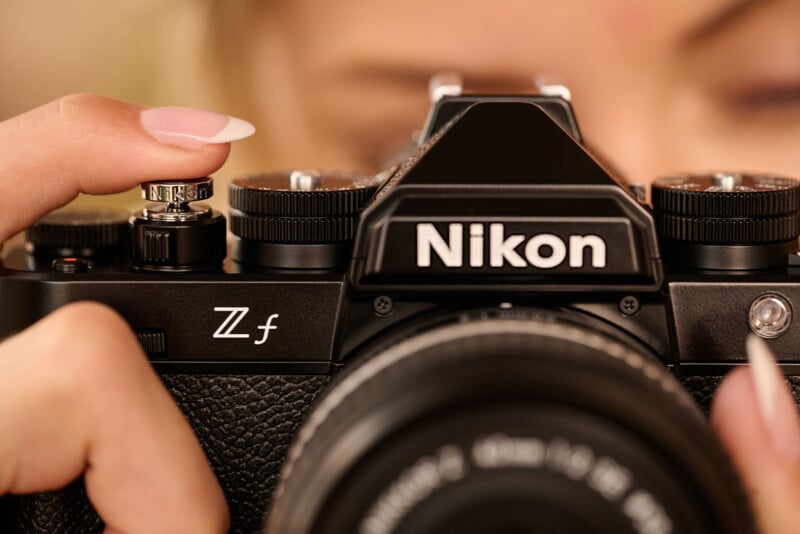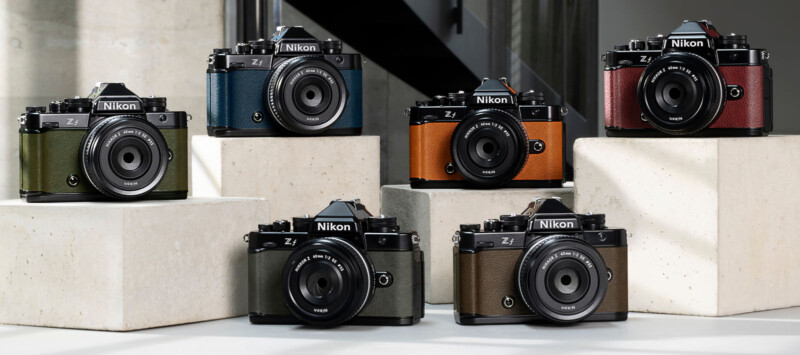The Nikon Zf Combines Classic, Timeless Style and Modern Tech
![]()
Nikon has announced the Zf, a retro-inspired camera that combines the iconic design of Nikon’s historic FM2 film camera and the modern technology of acclaimed Nikon Z series mirrorless cameras like the Nikon Z6 II, Z8, and flagship Z9.
Zf Combines EXPEED 7 and 24.5MP Full-Frame Image Sensor
At the core of the Nikon Zf is Nikon’s swift and powerful EXPEED 7 processing engine and 24.5-megapixel full-frame backside-illuminated CMOS image sensor. The powerful combination of the engine and sensor enables enhanced autofocus performance, fast shooting speeds, and impressive low-light capabilities. The processor also underpins some all-new features, including a 96-megapixel pixel-shift shooting mode and Nikon’s most advanced in-body image stabilization system.
![]()
“It’s exciting to see the leaps in innovation that propelled the Z9 trickling down, making the latest technology and features more accessible than ever before inside the Zf, a camera which is a beautiful marriage of form and function,” says Jay Vannatter, Executive Vice President, Nikon Inc. “The Zf is more than a means to simply capturing an image; using the camera is an experience unto itself, one which not only sparks creativity, but also elevates the user’s intent with its advanced performance and feature set.”
![]()
![]()
Increased Processing Power Bumps up the ISO
Beyond the marketing speak, there is much to discuss concerning the new Nikon Zf. While the image sensor offers the same resolution (24.5 megapixels) as the Nikon Z6 II, the Zf changes the native ISO range. While both cameras start at ISO 100, the Zf tops out at ISO 64,000, whereas the Z6 II’s native ISO speed is capped at ISO 51,200. This is a minor change, but one worth mentioning. As for the expanded range, both cameras offer ISO 50-204,800 ranges. Nikon says the increased ISO ceiling results from increased processing power and the BSI sensor.
![]()
No CFexpress Type B
Another change comes in how the camera records images. While the Z6 II sports a CFexpress Type B slot alongside a secondary UHS-II SD card slot, the Zf opts for an unusual UHS-II SD and UHS-I microSD slot pairing instead. While this has not impacted the Zf’s maximum speed relative to its 24.5-megapixel sibling — both cameras shoot full-resolution images at 14 frames per second — the shift away from CFexpress Type B will undoubtedly reduce buffer depths and buffer clearance rates, at least in certain situations.
![]()
Nikon’s Best Image Stabilization
On the other hand, the Zf’s five-axis in-body image stabilization system offers more performance. The Zf is rated to provide vibration reduction (VR) equivalent to eight stops, the best among all Nikon Z series cameras, and a three-stop improvement above the Z6 II.
IBIS Drives New 96MP Pixel-Shift Mode and Focus-Point VR
The move to a single EXPEED 7 processor from dual EXPEED 6 processors allows the Zf to perform a unique party trick — pixel-shift shooting. The Zf is the first Nikon camera capable of pixel-shift shooting and by combining 4, 8, 16, or 32 RAW (NEF) files, the Zf can create images up to 96 megapixels in resolution. Nikon promises this mode will deliver “the ultimate in fidelity” while reducing moiré, false colors, and noise. Like other cameras with pixel-shift shooting modes, the Zf achieves a higher resolution by precisely and subtly moving the image sensor using the stabilization system.

The stabilization system also supports focus-point VR, another first for Nikon. This sophisticated new stabilization mode minimizes blurring at the focus point rather than the center of the frame, even when the subject is positioned near the edge of the frame.
Z8-Caliber Autofocus Plus New Features
Concerning focusing near the edge of the frame, the Zf’s autofocus system covers approximately 96% of the horizontal axis of the image area, ensuring that it is easy to lock onto a subject, even when it is close to the edge of the frame.
![]()
The Zf sports an autofocus system driven by Deep Learning technology and offers Nikon’s famous 3D Tracking. The camera includes subject detection similar to the Z8, meaning the camera can identify and track people, dogs, cats, birds, cars, motorcycles, bicycles, trains, and planes. It can even detect the “world’s smallest face in the frame,” per Nikon, equivalent to approximately 3% of the frame’s longest side.
![]()
The Zf is designed with hands-on photography in mind, including manual photography. However, going fully manual, including with manual focus, does not mean giving up all modern amenities. For example, the Zf offers Eye/Face-Detection in MF mode, allowing the photographer to magnify the subject’s eye to nail manual focus instantly.
![]()
The Zf bests the Z6 II in terms of low-light autofocus capabilities. The Zf’s Starlight view mode boosts display brightness in extremely dark scenes, and the autofocus system can operate down to -10 EV, which is extremely dim.
New Black-and-White Modes
The camera also includes a couple of new black-and-white photography modes. The “Flat Monochrome” picture mode reproduces tones with a smooth gradation from shadow to light. The new “Deep Tone Monochrome” mode adds emphasis to dark tones, keeping mid-tones darker.
![]()
![]()
![]()
Form and Function
While a lot is happening inside the Zf, it is also carefully designed to look good.
“The heart of the Zf is ‘fusion’ — an idea embedded in the name while paying homage to important models through Nikon’s history. It represents the fusion of past, present and future. With an iconic exterior design reminiscent of the FM2, the Zf links Nikon’s heritage of innovation and precision craftsmanship. The magnesium-alloy body is durable and features a glossy finish, which is adorned with a classic Nikon logo. The characters on the mechanical dials for shutter speed, ISO and exposure compensation are all etched, and provide the user with satisfying tactile response, while the feel of the shutter-release button was given meticulous consideration,” Nikon explains.
![]()
The Zf doesn’t just look good, it also offers powerful usability features, including support for Touch Fn for adjusting camera settings while framing pictures through the viewfinder, yet another first for Nikon Z-series cameras.
Concerning the EVF and LCD, the EVF is a 3.69-million dot OLED panel with approximately 0.8x magnification. The rear panel is a 3.2-inch touchscreen with about 2.1 million dots. These are both identical to the Nikon Z6 II in terms of resolution. However, the Zf’s rear panel is a vari-angle display, a first for full-frame Nikon Z-series cameras.
![]()
The Nikon Zf’s body includes magnesium alloy on the front and top covers and promises high dust- and drip-resistance, alongside sealing on the exterior cover joints, shutter-release button, and vari-angle display mechanism. The camera is coated with an electro-conductive coat that Nikon says will ensure the surface stays cleaner (and easier to clean).
The Zf’s dimensions (width x height x depth) are 5.7 x 4.1 x 2 inches (144 x 103 x 49 millimeters), making the new camera 10mm wider than the Z6 II and just over 20mm thinner. The Zf weighs 1.57 pounds (710 grams) with its EN-EL15c battery and a memory card inserted, making it a mere five grams heavier than the Z6 II.
4K Video
The Zf shoots 4K/30p video oversampled from 6K. It can also record 4K/60p video using the DX (APS-C) image area and 1080/120p video. The Zf offers in-camera 10-bit H.265 recording. The camera can also record to an external recorder over USB-C or HDMI (Type D). It is worth noting that the Z6 II can shoot 4K/60p video using full pixel readout, a feature unavailable on the Zf.
![]()
Additional Sample Images
![]()
![]()
![]()
![]()
![]()
![]()
![]()
![]()
![]()
![]()
![]()
![]()
![]()
![]()
![]()
![]()
![]()
![]()
![]()
![]()
Pricing and Availability
The Nikon Zf will be available in a black finish starting in mid-October for $2,000 body only. It will also be sold in a kit with the retro-styled Nikkor Z 40mm f/2 SE lens for $2,240 or a Nikkor Z 24-70mm f/4 S lens for $2,600. These kits offer significant savings compared to buying the camera and lenses separately. In the case of the Nikkor Z 40mm f/2 lens, the kit is $70 cheaper. For the 24-70mm f/4 S kit, the savings jumps to $400.

For photographers who want a colorful Nikon Zf, Nikon will offer additional color options for $2,100 (body only) directly from the Nikon Store. The available colors include Indigo Blue, Sepia Brown, Bordeaux Red, Sunset Orange, Moss Green, and Stone Gray. These colors will be available in limited quantities.
Nikon has also announced that it is working with SmallRig on a custom grip bracket, although pricing and availability for this bracket is not yet available.
Image credits: Nikon